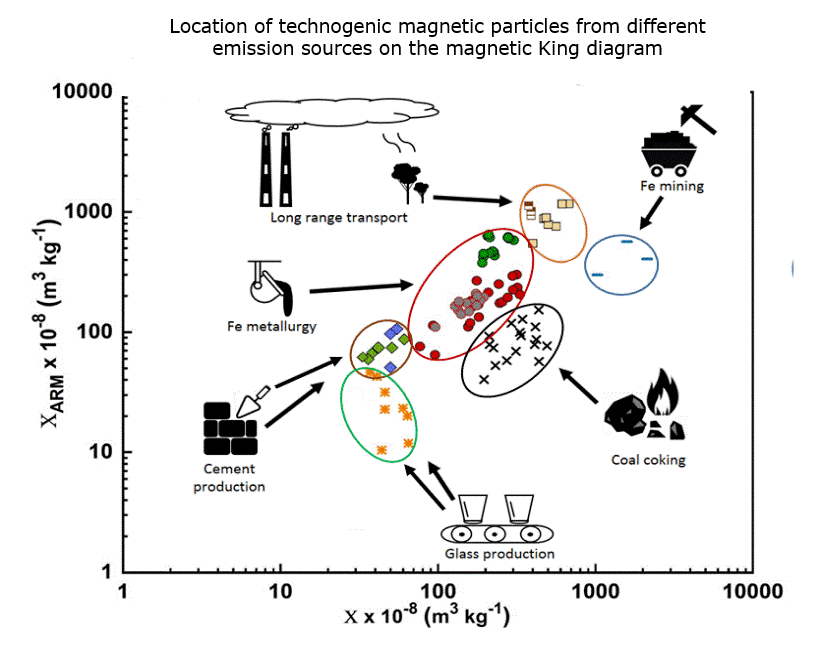Almost all urban and industrial dusts emitted into the atmosphere from various sources and eventually deposited in the soil contain a magnetic fraction. This fraction is known in the literature as "technogenic magnetic particles" (TMP). TMPs are iron minerals (mainly oxides) of anthropogenic origin that form during high-temperature processes from various forms of iron originally contained in raw materials, additives or fuels of various industries. Due to their ferrimagnetic properties, their presence in the soil environment, even in small quantities, can be detected by simple magnetic measurements (e.g. magnetic susceptibility).
 |
Since TMPs are carriers of many toxic and potentially toxic elements (mostly metals and metalloids), the measured values of magnetic susceptibility often correlate strongly with the content of these pollutants in the uppermost soil layers and are also used as an indicator of soil contamination. Previous studies carried out on urban and industrial dusts showed that TMPs emitted from different sources have different magnetic properties, certainly due to their different internal structure and mineral composition. The aim of the project was to investigate in detail the magnetic properties of TMPs present in the uppermost soil layers in areas that are now (or were in the near past) under the influence of certain emission sources (iron mining and metallurgy, steel production, coke production, cement and glass industries, transport, railways, etc.) and to determine the distinguishing parameters between and natural iron minerals present in soils and also between TMPs originating from different pollution sources. It was also important to answer the question of whether it is possible to identify the origin of TMPs found in soil in relation to the pollution source based on the combination of magnetic parameters. The results also provide a better understanding of the role of TMPs in transporting PTEs into the soil environment and their use as an indicator of pollution. |
The project results have shown that natural magnetite, which is present in soils as a result of weathering of the bedrock, and TMP differ significantly in their internal structure. In the case of TMP, which also has a spinel structure similar to natural magnetite, the defects in the crystal lattice are large. In addition to numerous defects and deformations in the crystal lattice, there are numerous substitutions of iron ions by cations of other metals. This affects the magnetic properties of these structures and both the analysis of the magnetic parameters (e.g. magnetisation and remanent magnetisation, magnetic coercivity parameters, etc.) and the Moessbauer spectra made it possible to distinguish natural magnetite from technogenic particles quite easily. During the project implementation, the characteristic magnetic and geochemical parameters of TMP were described and defined from different sources, resulting in a set of indicative parameters. Magnetic particles present in the topsoil near open pit iron mines, processing plants or mining dumps were found to be structurally similar to natural magnetite. These particles were termed anthropogenic because they enter the topsoil through human activities, but they are not typical TMP produced in high-temperature technological processes. They are characterised by a slightly lower stoichiometry compared to natural magnetite, which is due to the substitution of iron by Ti in the spinel structure or to structural defects caused by weathering processes in the tailings. An important feature of the particles originating from these sources was also a relatively high proportion of stoichiometric haematite. For TMP from soils surrounding old industrial sites that have been in operation for over 150 years, Moessbauer spectroscopy analyses showed a significant degree of oxidation and surface maghemitisation. TMP from traffic sources showed quite a wide range of magnetic parameters, but the distinguishing feature was the presence of metallic iron particles, which were easily identified from the shape of the thermomagnetic analysis curve. In the forest soil samples collected near iron and steel plants, a high correlation was found between the value of magnetic susceptibility and the content of Cr, Ni and Mn. These metals are typical of emissions from iron metallurgy. These elements showed much lower values of the correlation coefficient with magnetic susceptibility in the vicinity of other pollution sources. In the case of TMP contained in fly ash from power plants, the highest correlations with magnetic susceptibility were observed for Pb, Zn, Cd and Cu. In the combustion of hard coal, these metals were mainly present in the structure of iron oxides, and in the combustion of lignite, their greater amount was associated with the mobile fraction, which means that the fly ash after lignite combustion poses a greater environmental hazard than the dust after hard coal combustion. In each of the investigated areas with magnetic anomaly, metals that were highly present in the topsoil also had a high correlation coefficient with the measured magnetic susceptibility. This confirms the thesis that these metals were transported by TMP.






